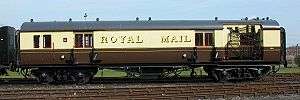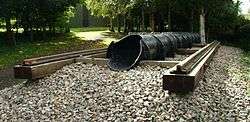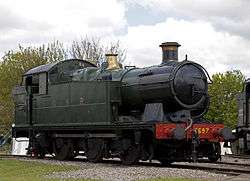Didcot Railway Centre
|
General view, including engine sheds, of part of the site | |
| Established | 1967 |
|---|---|
| Location | Didcot, Oxfordshire, England |
| Coordinates | 51°36′49″N 1°14′41″W / 51.613509°N 1.244772°WCoordinates: 51°36′49″N 1°14′41″W / 51.613509°N 1.244772°W |
| Type | Operational Railway museum |
| Key holdings |
GWR 6000 Class No.6023 King Edward II GWR 4073 Class No.4079 Pendennis Castle GWR Firefly Class Firefly |
| Owner | Great Western Society (site leased from Network Rail) |
| Public transit access | Didcot Parkway |
| Website | Didcot Railway Centre |
Didcot Railway Centre is a former Great Western Railway engine-shed and locomotive stabling point located in Didcot, Oxfordshire, England, which today has been converted into a railway museum and preservation engineering site.
Background
The founders and commercial backers of the GWR supported Isambard Kingdom Brunel's schema to develop an integrated railway and steam-ship service which allowed trans-Atlantic passengers and freight quicker passage to and from London to New York City. However, whilst backing the scheme the railway had to make a profit, and so it took a number of detours and added both mainline and branchline traffic to increase its domestic earnings. This earned the railway the nickname The Great Way Round from its detractors.[1]
Whilst the route from London Paddington to Reading was relatively straight, the then obvious most direct route to Bristol would have taken the railway further south, thus avoiding both Didcot and Swindon. However, passenger and freight traffic both to and from Oxford and onwards to the West Midlands in part dictated a more northerly route. Secondly Brunel had originally planned to cut through Savernake Forest near Marlborough, Wiltshire to Bristol, but the Marquess of Ailesbury, who owned the land, objected - having previously objected to part of the Kennet and Avon Canal running through his estate (see Bruce Tunnel). With the railway needing to run near to a canal at its midpoint - as it was cheaper to transport coal for trains along canals at this time - and with need for the branch northwards to Cheltenham via Stroud, Swindon was the next logical choice for the junction (and later railway works), 20 miles (32 km) north of the original route. This dictated that the Oxford junction also be moved northwards, and hence via Didcot.[1] The Great Western Railway built the first rail line through Didcot in 1839 and opened its first station in 1844.
Construction
Oct2001.jpg)
Due to the technical operational difficulties of running and maintaining a mainline service from London to Bristol, as well as the need for servicing locomotives going to Oxford, Didcot became an obvious midpoint maintenance and stabling point. Having built a timber-framed 7 ft 1⁄4 in (2,140 mm) broad gauge shed on the original site during the railways development west in the 1800s, in June 1932 a new steel-framed half-brick 4-road through shed (210 by 67 feet (64 m × 20 m)), was completed by the GWR under the Loans and Guarantees Act (1929). With shed code DID, it also included a repair shop (84 by 42 feet (26 m × 13 m)), coaling stage (43 by 36 feet (13 m × 11 m)), sand furnace (10 by 10 feet (3.0 m × 3.0 m)) and 65 feet (20 m) turntable plus associated offices (210 by 15 feet (64.0 m × 4.6 m)).[1] During World War II, a standard steel-framed with corrugated tin-panel covered ash shelter was erected.[1]
Operations
After World War II, the site remained virtually unchanged during the nationalised ownership of British Railways (BR), but for taking on the new code of 81E. The standard allocation of locomotives remained the same, with Halls, Dukedogs and Panniers making up the bulk of the depot's fleet.[1]
Closure
With the replacement of steam with diesel traction under the Beeching Axe, the shed was closed in June 1965.[1]
Formation and site lease
The Great Western Society (GWS) was offered the use of the former Didcot locomotive depot, taking it over in 1967. In the 1970s, the Society negotiated a long-term lease with BR which was to expire in 2019. But this was subject to a six-month termination clause which could force the GWS to quit the site, and which could operated at any point in time by lease-holder Network Rail (NR).
In an attempt to secure a long-term future for the society, in 2002 the GWS opened negotiations with NR to either purchase the site or extend the lease. In a letter dated May 2007, NR informed the GWS that they were prepared to sell the site subject to Office of Rail Regulation (ORR) approval. It had been thought the site could be subject to need as a depot, either due to: the rebuilding of Reading station; a Crossrail project depot; or the Intercity Express Programme. After expressing some concern at the slow speed of negotiations at the GWS annual meeting in September 2008, NR wrote to the GWS to advise that the site was no longer available for sale, and although a lease extension was still on offer it was still subject to the previous six-month termination clause. The GWS then wrote to their local MP Ed Vaizey, and placed any long term development plans on hold.[2] As of 6 October 2011 Richard Croucher (Chairman of the Great Western Society) signed a new 50-year lease with Network Rail, therefore preserving the site for at least another 50 years.
Museum and railway centre


| Railways around Didcot | |||||||||||||||||||||||||||||||||||||||||||||||||||||||||||||||||||||||||||||||||||||||||||||||||||||||||||||
|---|---|---|---|---|---|---|---|---|---|---|---|---|---|---|---|---|---|---|---|---|---|---|---|---|---|---|---|---|---|---|---|---|---|---|---|---|---|---|---|---|---|---|---|---|---|---|---|---|---|---|---|---|---|---|---|---|---|---|---|---|---|---|---|---|---|---|---|---|---|---|---|---|---|---|---|---|---|---|---|---|---|---|---|---|---|---|---|---|---|---|---|---|---|---|---|---|---|---|---|---|---|---|---|---|---|---|---|---|---|
Legend | |||||||||||||||||||||||||||||||||||||||||||||||||||||||||||||||||||||||||||||||||||||||||||||||||||||||||||||
| |||||||||||||||||||||||||||||||||||||||||||||||||||||||||||||||||||||||||||||||||||||||||||||||||||||||||||||
Today the GWS have developed the site, which still retains many of the original GWR buildings and features, as both a working steam locomotive and railway museum, engineering maintenance centre, and railway line offering short rides to visitors.
Access via Didcot Parkway station brings the visitor into the southern end of the site, at the start of the ramp coal wagons would take up to the coaling stage. Beyond this is the original 1932 four-road engine shed, and beyond this the original repair shed and 1988 constructed locomotive works, both of which have restricted access due to safety concerns. Beyond this lies a Ransomes & Rapier 70 feet (21 m) turntable and pit, originally built for the Southern Railway and installed at Southampton Docks.
The centre regularly holds events such as steam and diesel railcar days. Members of the Great Western Society are active in the preservation of locomotives and rolling stock. Certain 'new-build' projects to create locomotives that did not escape wholesale scrapping are also undertaken at Didcot, such as the completed Firefly locomotive, a 'Saint' class (using a 'Hall' class chassis and boiler) and a 'County' class locomotive (using a 'Hall' class chassis and an LMS '8F' class boiler).
Running lines
There are three short lengths of running track, each with a station at both ends:
- Branchline: starts at a typical GWR wayside halt, named Didcot Halt, and runs north on the western edge of the site towards the transshipment shed. Dating from broad gauge days, it was used for transferring goods from broad to "narrow" (i.e. 4 ft 8 1⁄2 in or 1,435 mm standard gauge) rolling stock and vice versa. It was moved to its present location carefully from its nearby original site.
- Broad gauge Line: the broad gauge line of 7 ft 1⁄4 in (2,140 mm) starts from the transshipment shed, and runs halfway back down the branchline. The 2005 replica GWR Firefly is housed within the shed when not running
- Mainline: starts opposite the site entrance, using a pre-fabricated concrete station platform from Eynsham, and runs on the eastern-edge of the site to a newly built platform at the other. Long-term plans include the reconstruction of the Brunel-designed building from Heyford station on this platform.
Access
The railway centre is entirely surrounded by active railway lines and has no road connection of any kind. Public access is on foot from a subway at Didcot Parkway railway station, which links the centre by rail to London and much of southern and central England. Wheelchair and pram access is practically nonexistent; they have to be carried up a flight of concrete steps. Although this contravenes the Disability Discrimination Act, the Great Western Society is unable to improve it since the site is owned by Network Rail.
Collection
Locomotives
| Class | Number (&Name) | Image | Status | Notes |
|---|---|---|---|---|
| GWR 7800 Class | 7808 Cookham Manor |
 |
Static Display | Built 1938 |
| GWR 7200 Class | 7202 |  |
Under Restoration | Built 1934 |
| GWR 6959 Class | 6998 Burton Agnes Hall |
 |
Static Display | Built 1949 |
| GWR 6100 Class | 6106 |  |
Static Display | Built 1931 |
| GWR 6000 Class | 6023 King Edward II |
.jpg) |
Operational | Built 1930. Returned to steam in 2010 after completion of a lengthy restoration from scrapyard condition, was even originaly purchased as a spares donor for sister engine 6024 King Edward I. Boiler ticket expires in 2020 |
| GWR 5700 Class | 3738 | .jpg) |
Static Display | Built 1937. Out of service August 2013 due to boiler crack |
| GWR 5700 Class | 3650 |  |
Static Display. | Built 1939. Boiler ticket expires 2018. Currently out of traffic due to tyre wear. |
| GWR 5600 Class | 6697 |  |
Static Display | Built 1928 |
| GWR 5205 Class | 5227 |  |
Static Display | Built 1924. One of the Barry Ten, it was purchased in 2010 to provide parts for the construction of the new-build GWR 4700 Class No. 4709. After donating its axleboxes and fourth axle to the project, it moved to Didcot in 2013 following storage at a private site. Currently on display in ex-scrapyard condition as a reminder of the challenge that preservationists had to conquer. The boiler is to be used for the GWR 3800 Class new-build project. |
| GWR 5101 Class | 4144 |  |
Under repairs | Built 1946. Boiler ticket expires 2025. A problem was found within its frames and is currently being looked at. |
| GWR 4900 Class | 5900 Hinderton Hall |
 |
Static Display | Built 1931 |
| GWR 4575 Class | 5572 | .jpg) |
Static Display | Built 1929 |
| GWR 4300 Class | 5322 | .jpg) |
Static Display[3] | Built 1917. Withdrawn in 2014 due to boiler problems, though its boiler ticket expires in 2018. |
| GWR 4073 Class | 4079 Pendennis Castle |
 |
Under Overhaul | Built 1924. This locomotive was repatriated from Australia in 2000 after spending 22 years in the country. |
| GWR 4073 Class | 5051 Earl Bathurst |
Static Display | Built 1936. Currently wearing its former name, Drysllwyn Castle. | |
| GWR 2900 Class | 2999 Lady of Legend |
Under Construction | Originally built 1929. Using components from No. 4942 Maindy Hall. | |
| GWR 2884 Class | 3822 |  |
Static Display | Built 1940. Appeared in the Queen music video Breakthru. |
| GWR 1400 Class | 1466 | .jpg) |
Static Display[4] | Built 1936. This was the first locomotive bought by the society, and is in the queue for a major overhaul.[5] |
| GWR 1361 Class | 1363 |  |
Under Overhaul | Built 1910 |
| GWR 1340 Class | 1340 Trojan |
.jpg) |
Static Display | Built 1897. Ex-Alexandra (Newport and South Wales) Docks and Railway. Painted in GWR green livery[6] |
| GWR 1000 Class | 1014 County of Glamorgan |
Under Construction | Built 1946 | |
| GWR Iron Duke Class | Iron Duke | .jpg) |
Static Display | Built 1985. Replica of early Broad Gauge 4-2-2. On loan from the National Railway Museum. |
| GWR Firefly Class | Firefly | Static Display | Built 2005. Replica of early Broad Gauge 2-2-2[7] | |
| GWR Railcar | No.22 | Operational | Built 1940 | |
| GWR 18000 | 18000 | Static Display | Arrived 29 July 2011. Owned by Pete Waterman[8] | |
| George England 0-4-0WT | No.5 |  |
Static Display | Built 1857, latterly owned by the Wantage Tramway. After inspection, too much original metalwork would need to be replaced to be brought back into working order.[9] |
| Hunslet 0-6-0ST | No. 2409 King George |
Under Overhaul | Built 1942. Currently being restored and rebuilt into a Thomas the Tank Engine lookalike. | |
| Kitson & Co. 0-4-0ST | No.1338 |  |
Static Display | Built 1898. Ex-Cardiff Railway[10] |
| RS&H 0-4-0T | No.1 Bonnie Prince Charlie |
 |
Static Display | Awaiting overhaul. Painted in lined light green livery.[11] |
| British Rail Class 14 | D9516 | Operational | Built 1964. Bought from the Wensleydale Railway in 2014. | |
| British Rail Class 08 | 08604 Phantom |
 |
Operational[12] | Built Derby Works as D3771, allocated to: Longsight (9A) June 1959; Stockport Edgely (9B) July 1959; Longsight (9A) April 1965, unofficially named Ardwick; renumbered 08604 February 1974; stored Swindon Works 1981; Tyseley TMD February 1984, unofficially renamed Javelin, officially then named Phantom; Bescott November 1988; Derby Etches Park November 1992; withdrawn in July 1993. Sold to GWS and moved to DRC September 1994 |
Other rolling stock
The GWS has an extensive supporting collection of GWR rolling stock, including three of the GWR Super Saloons that serviced the boat train traffic to Plymouth.
References
- 1 2 3 4 5 6 E.T. Lyons. An Historical Survey of Great Western Engine Sheds: 1837–1947. Oxford Publishing. ISBN 086093019X.
- ↑ "Latest news – Didcot Railway Centre". Didcotrailwaycentre.org.uk. Retrieved 2012-08-07.
- ↑ "5322". Didcot Railway Centre. Retrieved 8 February 2015.
- ↑ "1466/4866". Didcot Railway Centre. 3 July 2013. Retrieved 8 February 2015.
- ↑ "News Archive - 2013". Didcot Railway Centre. Didcot. 1466 'Now available in Black'. Retrieved 8 February 2015.
- ↑ 1340 – Trojan. Didcotrailwaycentre.org.uk (2007-10-07). Retrieved on 2011-03-02.
- ↑ Fire Fly – 2-2-2. Didcotrailwaycentre.org.uk (2010-11-27). Retrieved on 2011-03-02.
- ↑ "News | Latest News". Didcot Railway Centre. Retrieved 2012-08-07.
- ↑ No.5 – Shannon/Jane. Didcotrailwaycentre.org.uk (2010-07-11). Retrieved on 2011-03-02.
- ↑ 1338 – 0-4-0ST. Didcotrailwaycentre.org.uk (2010-11-01). Retrieved on 2011-03-02.
- ↑ No. 1 – Bonnie Prince Charlie. Didcotrailwaycentre.org.uk (2007-12-25). Retrieved on 2011-03-02.
- ↑ "08 604 "Phantom"". Didcot Railway Centre. 19 August 2010. Retrieved 8 February 2015.
External links
| Wikimedia Commons has media related to Didcot Railway Centre. |
- Official website
- Listed building information:
- Map sources for Didcot Railway Centre